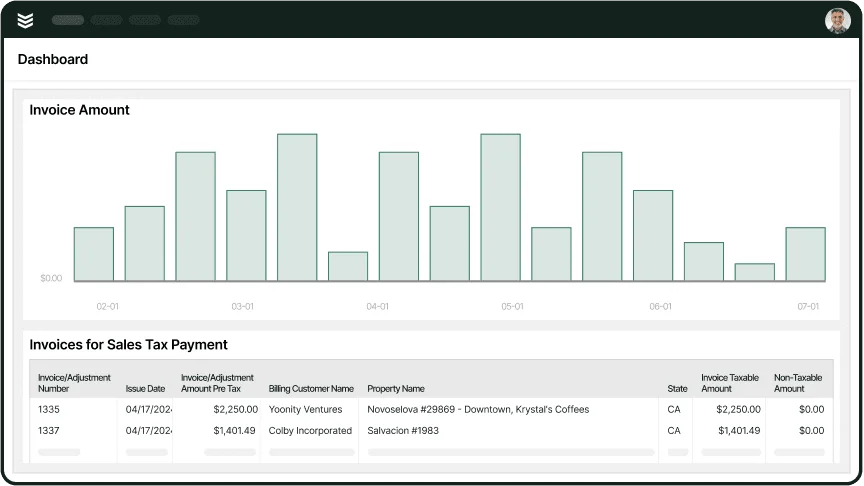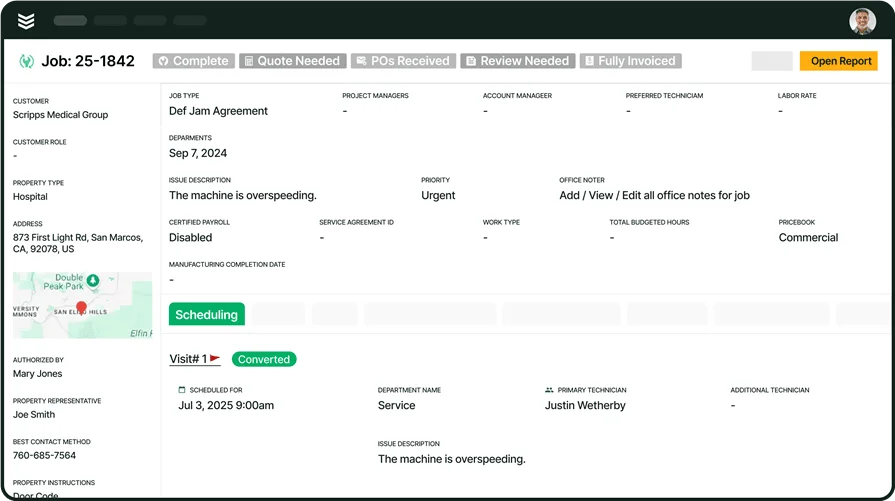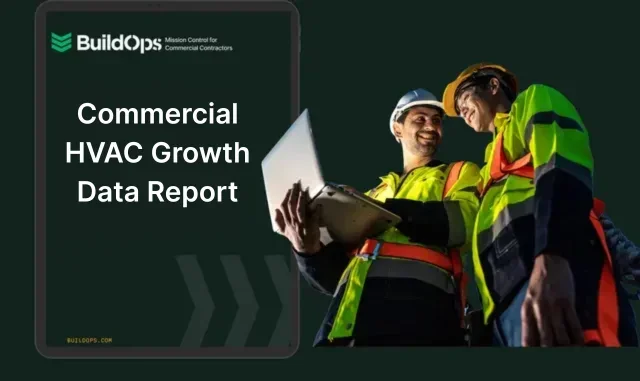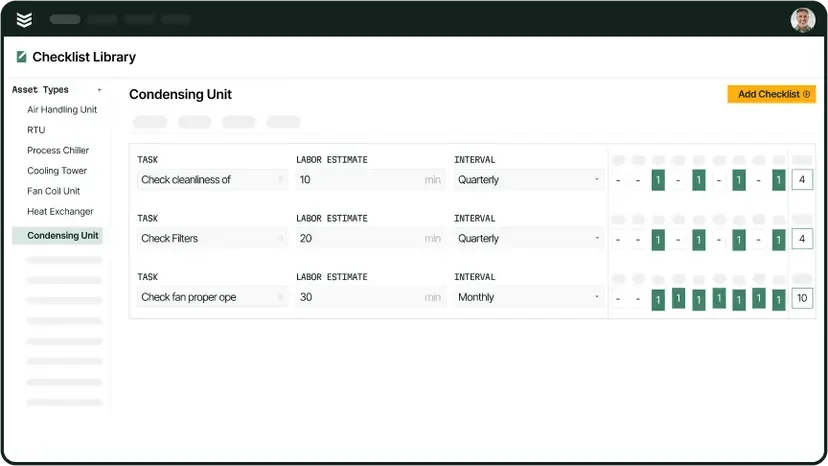When your crew finishes a service call, that final step—documenting the work—can be the thing that keeps your business running tight or leaves you scrambling later. Sloppy paperwork, missing signatures, or incomplete notes drag down your whole operation.
That’s where HVAC service report apps come in. These tools help field teams capture job details in real time—snap photos, log parts used, track time on-site—all from their phone or tablet. And for companies in the HVAC industry, using the right service report app means faster invoicing, fewer callbacks, and better customer communication.
- Choosing the right HVAC service report app for your techs
- 6 key features to look for in an HVAC service report app
- Types of HVAC service report apps
- 6 best HVAC service report apps for your field technicians
- 7 benefits of using an HVAC service report app
- 4 important HVAC service report app FAQs answered
Next, we’ll walk through how to choose an HVAC service report app that fits your team’s workflow—not just one that looks good on paper.
Choosing the right HVAC service report app for your techs
When your crew's out in the field, every step needs to run smoothly—especially when it comes to documenting the work. HVAC service report apps take the hassle out of paperwork by making it easier to log service details, track parts, and send updates back to the office on the spot. But not every app fits how your team actually works. Choosing the best one takes more than just comparing feature lists. You need to think about what your techs deal with day-to-day, and how the app will hold up under real job conditions.
- Job site flexibility – Can techs submit reports without a signal? Does the app work on both iOS and Android? Can they snap photos, collect signatures, and log notes directly from the field?
- Workflow compatibility – Will it handle recurring service calls and last-minute dispatches? Can it pull in job history or sync with the systems you're already using?
- Ease of use in the field – Can a tech knock out a report while standing at the truck? Will new hires figure it out without needing a manual? Does it keep things simple without skipping the details?
- Reporting accuracy – Does it prompt techs to fill out everything they need to log? Can it tag parts, labor, and timestamps automatically? Does it cut down on back-and-forth to fix missing info?
- Features – Can you tailor the app to your reporting needs? Will it generate clean PDFs, store service histories, and link to customer records? How well does it handle attachments like photos or signed approvals?
Let’s look at the key features that help HVAC service report apps deliver where it counts—on speed, accuracy, and making your crew’s lives easier.
6 key features to look for in an HVAC service report app
When you're reviewing HVAC service report apps, you’re not just looking for a digital notepad. You’re evaluating whether the app can hold up in daily field use, deliver clear and complete reports, and connect seamlessly to the rest of your operations. These tools need to help your crew move faster, stay consistent, and avoid errors that delay billing or cause callbacks.
Here are six features every HVAC team should expect from a reporting app built to perform on the job:
1. Mobile functionality
The app should work cleanly across devices—whether it’s a tablet in the truck or a phone on a ladder. Key functions like adding photos, capturing signatures, tagging materials, and submitting completed reports should all be available offline. An HVAC tech doesn’t always have a signal in a basement or mechanical room. The app needs to let them keep working, then sync automatically once they reconnect. Apps with full technician mobile app access reduce downtime and eliminate gaps in reporting. In the field, techs often shift between multiple sites. Being able to log work in real time, regardless of connection, keeps data accurate and speeds up handoff to the office.
2. Time tracking
Manual time entry leads to errors that mess with payroll, job costing, and customer trust. A strong service report app includes built-in time tracking that logs labor time down to the minute—start, pause, and stop—without relying on memory. It should also track time spent per job, especially when techs handle multiple calls per day. Time tracking tools tied directly to service reports simplify back-office tasks and give clear records if there’s ever a dispute about labor hours.
3. Job scheduling visibility
Field techs need to see what’s next, not just what’s now. Service report apps should tie into your scheduling system so techs can view their upcoming jobs, time windows, and client notes without calling dispatch. Bonus points if they can also access job history or prep notes directly in the same view. Job scheduling visibility gives techs context before they arrive, helping them log accurate reports and reduce unnecessary follow-ups.
4. Dispatch integration
The moment a job is assigned, the service report app should reflect that assignment and carry over all critical job details—location, priority, equipment type, and customer instructions. This reduces double entry, improves clarity, and keeps the reporting aligned with dispatch expectations. Dispatch integration also ensures that if a call gets reassigned or rerouted, the tech has the latest info without having to wait for a phone call or check back at the office.
5. Invoicing and payments
A good HVAC service report app should automatically carry job details—like logged labor, used parts, and follow-up recommendations—into your invoicing system. That tight handoff saves your office team from tracking down techs for missing info and keeps billing accurate. The same app should also support collecting payments, whether that’s capturing a signature for a service agreement or taking a card payment on-site. This is especially useful for jobs that wrap same-day. With invoicing and payment tools tied directly to reporting, your techs can close the loop fast—from fixing the issue to collecting the check—without bouncing between apps or delaying cash flow.
6. Service history access
Being able to pull up past reports, flagged issues, and signed approvals saves time and improves service quality. HVAC techs should be able to check what’s been done on a unit before, rather than guessing or asking the office to send documents over. With direct service history access, field teams can make better decisions and avoid repeating work—especially for recurring service contracts or complex multi-site accounts.

Explore our reporting product
BuildOps connects HVAC pros with the insights they need to get better.
Other valuable features to have in an electrical load calculation software
Not every HVAC service report app needs to be loaded with extras—but some added features can save time, improve follow-ups, and keep your pipeline running smoothly. These are the kinds of tools that don’t always make the top list but end up being difference-makers in the long run. Especially if your team’s handling high job volume, long-term service agreements, or juggling multiple client contacts.
- CRM integration – Linking service reporting to a customer management system gives your techs and office staff access to client histories, property details, and contact info in one place. It’s especially useful when handling recurring clients or multiple stakeholders per site.
- Quote generation tools – Being able to flag recommended work and convert it into a quote directly from the report adds serious efficiency. A quoting feature connected to the reporting app helps techs pass notes to the sales team or create quick estimates without re-entering job details.
- Pipeline visibility – Seeing open jobs, flagged follow-ups, and pending service items from a high level helps office teams prioritize tasks. Pipeline tracking supports smoother handoffs between field and office, especially when reports feed directly into sales or service workflows.
These aren’t mandatory to have on day one—but they become powerful when layered onto a well-run reporting process. Now that we've covered the feature set, let’s break down the types of HVAC service report apps out there—and which setups work best for different team sizes and service models.
Types of HVAC service report apps
The way your team captures and handles service reports depends a lot on the kind of app powering your process. Each app type has its strengths—and a few trade-offs. Whether you’re running calls from the office or managing crews across job sites, knowing the differences can help you choose the setup that fits your workflow.
- Cloud-based – These apps store data online, giving your techs and office team access from anywhere. They sync job info in real time and reduce the chance of lost paperwork. However, performance depends on internet access—offline environments may delay updates until reconnected.
- Web-based – Browser-based platforms work well for back-office users who manage jobs from a desktop. They don’t require installations and are easy to access. That said, most aren’t built for mobile use and can fall short when your techs need to log reports on-site from their phones.
- On-premise – These are hosted on your company’s own servers, giving you full control over data and security. It’s a good match for organizations with in-house IT. But setup is complex, updates are slower, and scaling can be a challenge as your team grows.
- Mobile – Designed for smartphones and tablets, these apps allow your field techs to complete service reports quickly on the job. They’re fast, simple, and easy to train on. The trade-off is that they often have limited admin functionality, so they may need to be paired with another platform for office tasks.
- All-in-one field service platforms – These tools combine everything—reporting, dispatch, customer records, scheduling, and quoting—into one interface. That means fewer tools to juggle, fewer manual handoffs, and a clearer view of your operations. Learn how field service management platforms help HVAC companies stay efficient while scaling up.
Each type serves a different role depending on your setup, team size, and how work flows between the field and the office. Matching the tool to your real-world needs makes all the difference when your team is juggling jobs, tracking parts, and closing out reports.
6 best HVAC service report apps for your field technicians
When your techs are on the move all day, the tools they use need to keep up. HVAC service report apps should make documenting work quick, clear, and effortless—without creating extra steps. The best apps make it easy to capture job info in real time, while also tying into your office systems for invoicing, customer follow-up, and more. These six solutions stand out for field usability, feature depth, and how well they support daily reporting in HVAC service environments.
1. Best for commercial: BuildOps
BuildOps gives commercial contractors a clean way to manage service reporting from the field. Reports connect directly to job history, asset tags, photos, and notes—all accessible from a mobile-first interface that’s designed for fast use in the field. Technicians can complete, send, and update reports without breaking their workflow or relying on separate tools.
App type: Cloud-based software, mobile-first application
How pricing works: Custom quotes based on team size and feature needs
Features beyond service reporting: The platform ties reporting to key operational tools—quoting, dispatch, CRM, scheduling, invoicing, and maintenance planning. Techs can also view customer details, past jobs, and job checklists directly inside the mobile app, reducing friction and improving reporting accuracy.
What sets it apart for specialization: BuildOps supports multi-location commercial service workflows, which is ideal for contractors handling large facilities or long-term accounts. Everything flows from one job phase to the next—from scheduling to reporting to billing—all in one system.

See our reporting tool in action
Find out how BuildOps helps HVAC teams get deep, meaningful insights.
2. Best for residential: Housecall Pro
Image Source: Housecall Pro
Housecall Pro is widely used among residential HVAC businesses for its mobile-friendly interface and built-in automation features. Techs can use the app to log job details, share updates with customers, and generate follow-up communications—all from the same place. While it's solid for basic service reporting, the tool can fall short for teams needing complex workflows or more advanced reporting control.
App type: Cloud-based and mobile-ready
How pricing works: Starts at $59/month with scaled tiers for added features
Features beyond service reporting: Housecall Pro includes appointment reminders, invoicing, and payments. It also offers customer history tracking and marketing automation, making it easier to manage residential relationships long term.
What sets it apart for residential: Built with residential service teams in mind, the app is simple to navigate and doesn’t require deep training to get started. It helps smaller HVAC teams stay organized and responsive without adding too much overhead.
3. Best for general contractors: Jobber
Image Source: Jobber
Jobber helps general contractors, including HVAC service businesses, manage jobs, track customer info, and document work performed. Its reporting tools are built into a broader scheduling and client management platform. For HVAC teams handling mostly commercial or complex service agreements, though, the app’s customization options for reports may feel limited.
App type: Cloud-based with desktop and mobile access
How pricing works: Plans start around $25/month for a single user, with tiered upgrades for added features
Features beyond service reporting: Jobber supports online booking, job tracking, customer communication, and invoicing. It’s designed to keep admin work organized across multiple clients and job types, especially in service-focused businesses.
What sets it apart for general contractors: The platform works well for contractors juggling many small-to-midsize service jobs. Its strength is in combining customer info and scheduling into one dashboard, with enough reporting tools to meet basic needs without overcomplication.
4. Best for small to mid-sized businesses: ServiceTitan
Image Source: ServiceTitan
ServiceTitan is built to handle the core operations of growing HVAC service companies, including reporting, scheduling, and sales. It offers strong tools for job tracking, technician dispatch, and real-time updates. While feature-rich, its complexity can be a hurdle for smaller teams or those looking for a faster setup.
App type: Cloud-based with mobile capabilities
How pricing works: Custom pricing based on business size and modules used
Features beyond service reporting: ServiceTitan includes built-in marketing tools, proposal generation, job costing, and customer communication features. It also connects service reports with parts usage and time tracking for stronger operational oversight.
What sets it apart for small to mid-sized businesses: This platform is built for HVAC businesses scaling up from pen-and-paper or simple tools. It’s strong in reporting accuracy, technician oversight, and automated follow-ups—all key for mid-sized operations looking to improve job tracking.
5. Best for independent contractors: FieldEdge
Image Source: FieldEdge
FieldEdge offers HVAC contractors a solid mobile tool for logging service reports, accessing job details, and managing work orders from anywhere. It balances simplicity with useful back-office integrations. For highly specialized or enterprise-level operations, though, its reporting and customization options may feel limited.
App type: Cloud-based with desktop and mobile interfaces
How pricing works: Custom quotes available through their sales team
Features beyond service reporting: FieldEdge connects reporting with dispatch, maintenance scheduling, and customer profiles. It also offers QuickBooks integration for billing and basic customer management tools for solo contractors or small teams.
What sets it apart for independent contractors: Ideal for contractors who wear multiple hats—tech, admin, and business owner. It streamlines essential service documentation while still giving users access to billing and scheduling from the same system.
6. Best for specialty HVAC contractors: Workiz
Image Source: Workiz
Workiz caters to niche HVAC contractors who offer specialized or emergency services and need fast, mobile-friendly job tracking. The app offers simple service report generation with the ability to attach photos, notes, and client signatures. However, for teams needing deeper customization or heavy reporting capabilities, it may not be robust enough.
App type: Cloud-based with strong mobile support
How pricing works: Starts at around $225/month for 3 users, with pricing that scales by team size
Features beyond service reporting: Workiz includes features like call tracking, team messaging, and sales pipeline tools. It allows teams to capture reports, send quotes, and follow up from one place.
What sets it apart for specialty contractors: This app works best for teams offering urgent or one-off service calls. It simplifies service reporting without overloading the interface, helping techs get reports done quickly and move to the next job.

Get the HVAC Growth Report
See how leading HVAC pros streamline operations and grow their business.
7 benefits of using an HVAC service report app
Service reports don’t just track what got fixed—they shape how your team operates, how fast you get paid, and how professional your business looks. HVAC service report apps aren’t just a tool for techs—they’re a system-wide upgrade that helps you tighten up your workflow from the jobsite to the back office. Here’s what that means in practice:
1. Faster invoicing and fewer billing errors
Accurate service reports cut out the guesswork. When techs capture labor, materials, and job notes on the spot, billing teams don’t have to follow up later. This helps ensure invoices match the work done, reducing payment delays. Tying reporting directly into HVAC invoicing processes keeps your revenue moving without slowdowns from missing data.
2. Stronger estimating and quoting over time
Logged reports build a history of labor hours, parts used, and service timeframes—data that feeds smarter future estimates. Over time, this helps contractors quote jobs with more confidence and less padding. Apps that track field inputs give you a clearer picture of your actual job costs, making tools like an HVAC estimator app even more accurate.
3. More complete customer records
Service reports that feed into your CRM give everyone—from techs to office staff—a better view of each customer’s equipment, history, and preferences. That helps teams deliver better service and faster follow-ups. Connecting reporting to HVAC CRM software lets you build a full picture of every account.
4. Cleaner handoffs between field and office
Reporting apps make it easier for techs to pass info to the office without gaps, which keeps admin work moving and avoids duplication. Instead of chasing down job notes, your team can act on the info right away. That tight link between the field and admin improves everything from HVAC billing cycles to inventory restocking.
5. Easier management of service agreements
With recurring jobs, service reports help track what was done and what’s next. That’s critical for managing long-term service agreements where consistency matters. When apps support recurring job tagging, it pairs naturally with HVAC service agreement software to track and deliver on contract terms without missed steps.
6. Clearer documentation for disputes and legal backup
A detailed report with time logs, photos, and signatures can settle most disputes before they grow. It’s your best backup when customers question what was done or who was on-site. For teams that use formal HVAC contract templates, having linked reports to match each job keeps everything organized and documented.
7. Better performance visibility across your team
Once reporting is consistent, you get clear data on how long jobs take, what tools are used, and how each tech is performing. That helps owners make informed decisions on staffing, training, and workload distribution—without relying on guesswork. The app becomes more than just a log—it’s a lens into how your team works.
4 important HVAC service report app FAQs answered
When you’re deciding whether to bring a reporting app into your operation, there’s a good chance you’ve got questions. Here are the ones HVAC contractors ask most—answered plainly and directly, with no filler.
1. What is an HVAC service report app?
An HVAC service report app is a tool that lets technicians log job details, parts used, time on-site, photos, and signatures—all from a mobile device—then send that report straight to the office or client. It replaces handwritten forms with real-time, structured reporting built for the field.
These apps are built to replace paperwork and make reporting faster, more accurate, and easier to track. Instead of scribbled notes or missing forms, everything is documented in one place and available when you need it.
2. How do HVAC service report apps work?
HVAC service report apps work by guiding techs through each job with a structured digital form. Technicians can input job details, snap photos, tag materials, log hours, and collect digital signatures directly on their phone or tablet.
Once submitted, reports are stored in the system and instantly accessible to office teams. Some apps also link directly to other tools like scheduling, dispatch, or invoicing. This means updates flow across the company in real-time—no scanning, no chasing down paperwork.
3. Is the cost of an HVAC service report app worth it?
Yes—when used properly, it pays for itself in time saved and fewer mistakes. Manual reporting eats up time and often leads to lost info or incorrect billing. A digital system closes that gap by capturing details right when the work is done. It also helps with job history, warranty validation, and even legal documentation. If your team handles multiple jobs per day, the time and accuracy gains alone often outweigh the monthly cost of a reporting tool.
4. What are some best practices to follow when implementing an HVAC service report app?
Rolling out a new tool doesn’t have to slow your crew down. Here are a few proven ways to make the switch go smoother:
- Involve your field techs in choosing the tool
- Test it on a small number of jobs first
- Keep the reporting form simple and focused
- Train your team using real job scenarios
- Make sure the app works offline
- Sync it with your scheduling or dispatch tools
- Set a clear deadline for switching over
- Track early reports for gaps or issues
- Create a go-to person for troubleshooting
- Use the first 30 days to get feedback and adjust
Keeping the process tight early on builds long-term habits and makes the app a reliable part of every job.
Whether you're running five trucks or fifty, HVAC service report apps are the backbone of efficient field work. They cut down on paperwork, keep job details clear, and make sure nothing falls through the cracks. But here’s the part most shops miss—half the tools out there only cover the basics.
What we’ve covered in this guide—reporting tied to dispatch, time tracking, customer records, quoting, and payment—isn’t standard in most tools. BuildOps brings all of that together in one platform, designed specifically for commercial contractors who can’t afford gaps in the process. It’s not about piling on features—it’s about giving your team exactly what they need, where they need it.

Curious how BuildOps works?
Turn every single data point into a report, connecting you with deep insights.








